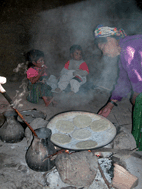As a part of a longitudinal study in the highlands of Guatemala to elicit the chronic health effects of wood smoke from cooking, mean area and personal 48 h concentrations of 2.5 µm particulate matter (PM2.5) and carbon monoxide (CO) were measured every 3 months over 19 months. Monitoring was conducted in 63 households, 28 using traditional open wood fires and 35 using wood cookstoves with chimneys. The goal of this paper is to estimate personal exposure concentrations to PM2.5 using the measurements from CO diffusion tubes as a proxy. CO tubes are cheaper and easier to use than PM-monitoring devices, and can be worn by all family members, even infants. The relationship of PM2.5 and CO was determined by comparing measurements from both co-located instruments. CO measurements in ppm were corrected for temperature and pressure to mass concentrations. PM2.5 exposure was modeled with the following linear regression created using measured concentrations: PM2.5 (mg m−3) = 0.10 (0.093, 0.12) × CO (mg m−3) + 0.067 (0.0069, 0.13), R2 = 0.76. No significant difference was found between the separate regressions for open fires and cookstoves. No significant improvement was obtained by applying a mixed statistical model. The equation was used to estimate personal exposures of PM2.5 using personal CO measurements from CO tubes worn by women, infants under 18 months, and children 48–72 months. Estimated 48 h mean personal PM2.5 concentrations for mother, infants, and children in open-fire homes were 0.27 ± 0.02, 0.20 ± 0.02, and 0.16 ± 0.02 mg m−3 respectively. In chimney-stove homes, mothers and children experienced PM2.5 personal concentrations of 0.22 ± 0.03 and 0.14 ± 0.03 mg m−3, respectively.

You have access to this article
 Please wait while we load your content...
Something went wrong. Try again?
Please wait while we load your content...
Something went wrong. Try again?


 Please wait while we load your content...
Please wait while we load your content...